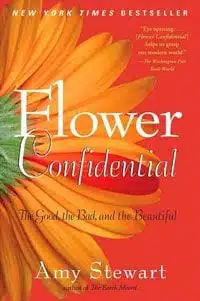
Not that we need another powerful example of the complicated, deceptive webs that produce the commodities we consume, but Amy Stewart’s Flower Confidential is exactly that. Though the image of flowers may be one of lighthearted, decorative, even joyful accents to daily life, they are in fact a multi-billion dollar market commodity. Using broad and perceptive journalism, Stewart examines the floral industry at each level of experimentation, research, breeding, growing, shipping, and marketing — and much that she uncovers and illuminates proves surprising.
Flower Confidential, now out in paperback, is a fascinating read for anyone interested in flowers, commodities markets, globalization, or economics. Several excellent reviews attended this book’s initial release, and all concentrate on Stewart’s enthusiastic observation and thoughtful journalism. Stewart’s style and the presentation of her findings are easily the best part of this book. Flower Confidential is full of interesting characters that breathe life into Stewart’s story and give perspective to some of the disturbing details. This is not a beach book, but reading it during the summer inevitably changes your perspective on all of the flowers that abound during this season.
Stewart writes with an engaging narrative voice about flower markets all over the world, producing both the familiar and the exotic, and sheds light on the stories of the individuals involved in creating, growing, and distributing flowers. These are complex characters from all over the floral industry spectrum. Even within a specific locale, the connections of commerce allow for comparison and contrast.
For example, Stewart introduces readers to third-generation American-Italian flower grower Don Garibaldi, still in California growing the violets and other field-grown flowers that his grandfather built the family business on. At the other end of the California cut flower chain, Stewart offers readers a glimpse into the professional life of Teresa Sabankaya, who runs a flower stand featuring seasonal, old-fashioned, and unusual flowers.
Stewart gives weight to these vignettes by including a host of international and domestic growers, breeders, and buyers. Every location and every character presents new challenges — from weather concerns and environmental hazards like chemical pesticides, to sexual harassment of female floral industry workers and technological innovations in crop science.
Stewart writes with passion about something she clearly cares very much about — it’s clear that flowers are important to Stewart and her careful investigation reflects her deep interest. This is not a soft, superficial examination of the floral industry. Stewart probes into the complex processes that make such a stunning and wide variety of flowers available in markets across the world. Often, what’s revealed isn’t so beautiful.
It is difficult to make room in our lives for contemplation of all the commodities that damage the environment, undermine democracy and free markets, oppress the poor, and generally contribute to the perceived evils of globalization, and maybe that is the downside of Stewart’s very well-written book. We want to think of flowers as innocuous symbols of affection, sympathy, or forgiveness — we do not want to think about the attendant costs and consequences of bringing beautiful flowers to a hostess, or a first date, or to our mothers.
Reading this book will change the way you look at flowers in the florist’s shop, the grocery store, or on the corner. Whether these individual changes will result in changes in the larger floral industry remains to be seen. Flower Confidential earned a place on the New York Times best-seller list, but has so far failed to generate the kind of visibility and action achieved by Michael Pollan with The Omnivore’s Dilemma, for example.
Undoubtedly, Stewart’s book has salience in a marketplace increasingly crowded by socially and environmentally responsible products and services. But perhaps that same seeming innocuousness of flowers will continue to allow this sometimes invasive industry to flourish.
So…add cut flowers to that long list of suspect commodities which already includes fruit, chocolate, coffee, stonewashed jeans, wooden floors and furniture, oil, fish….
